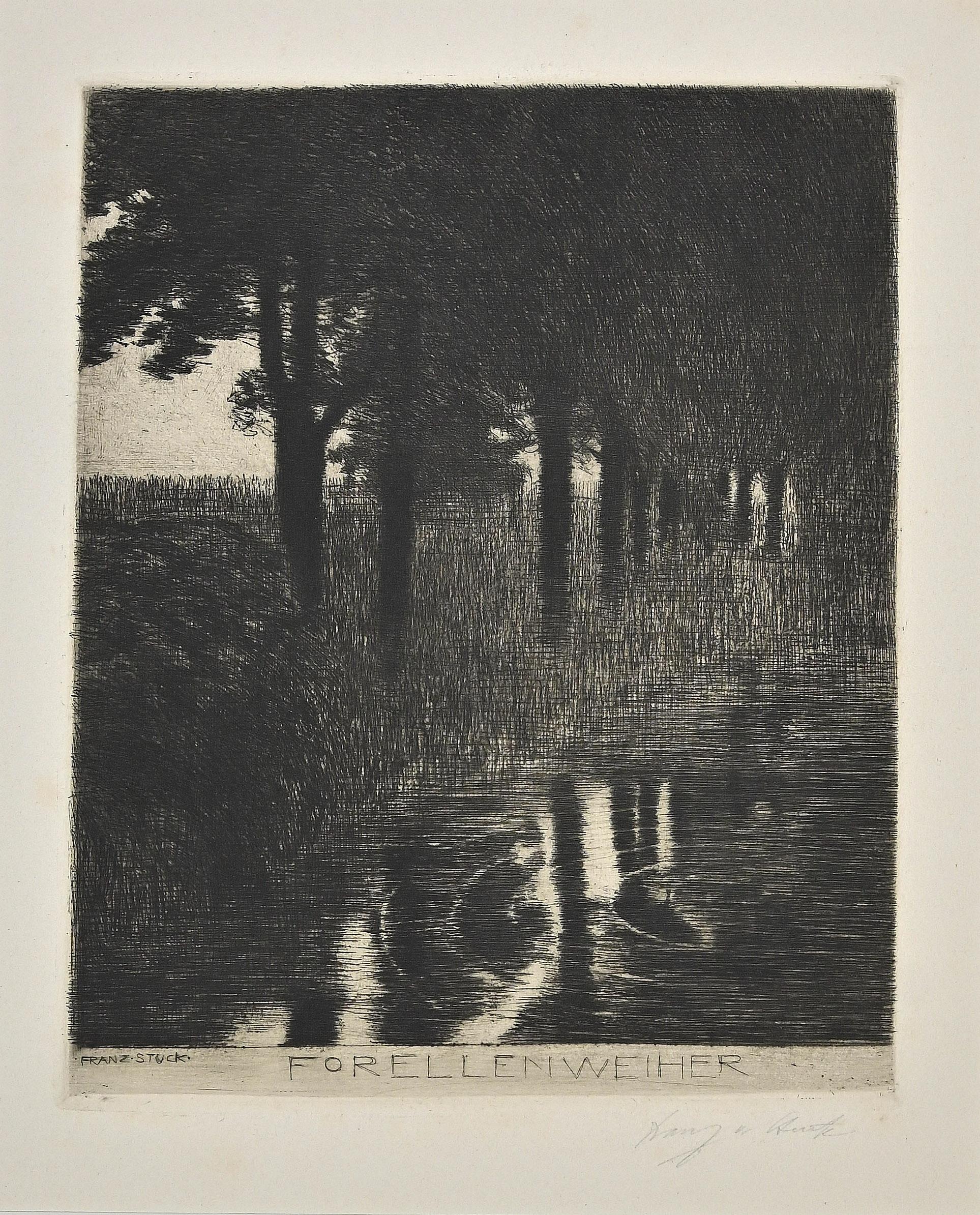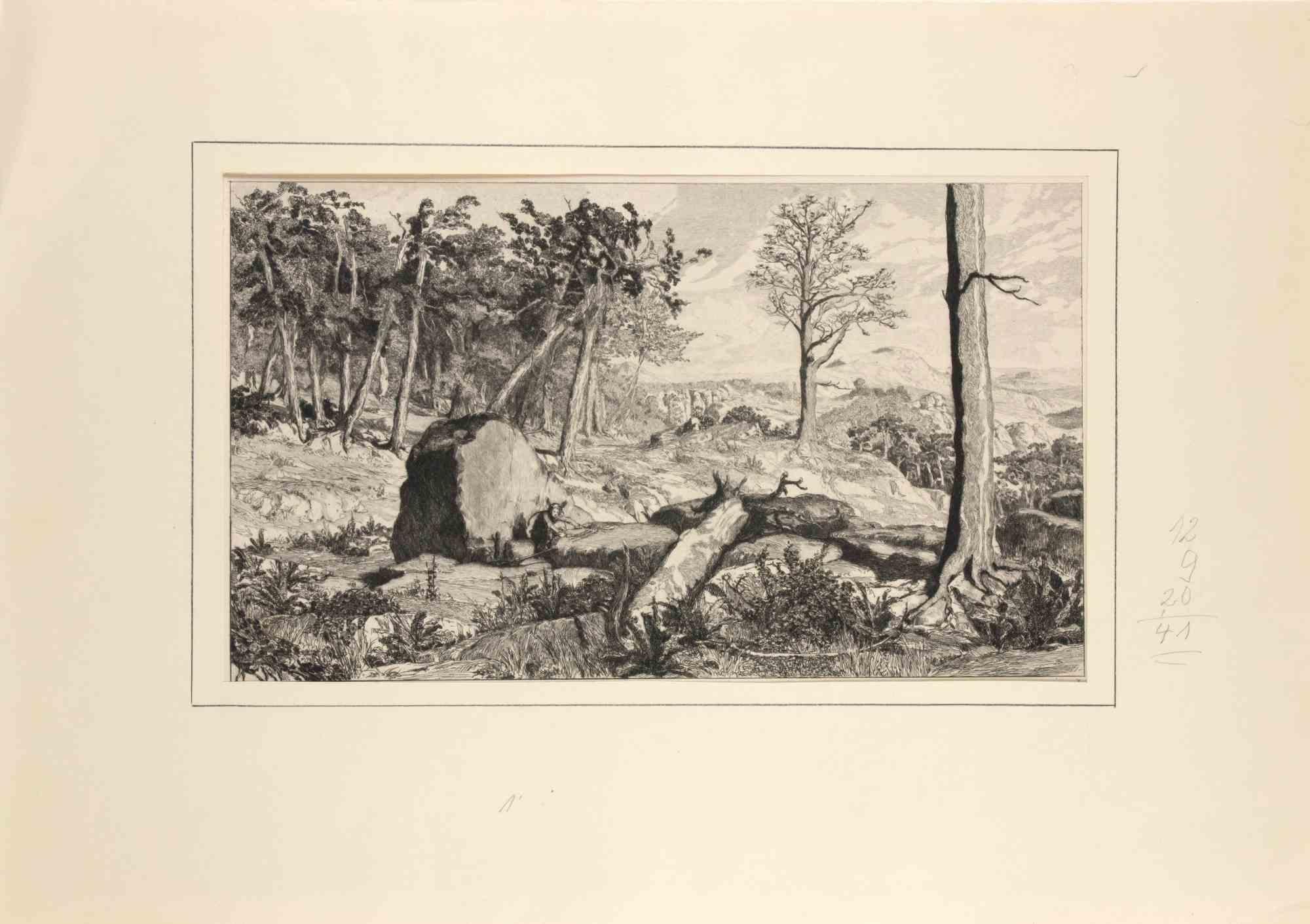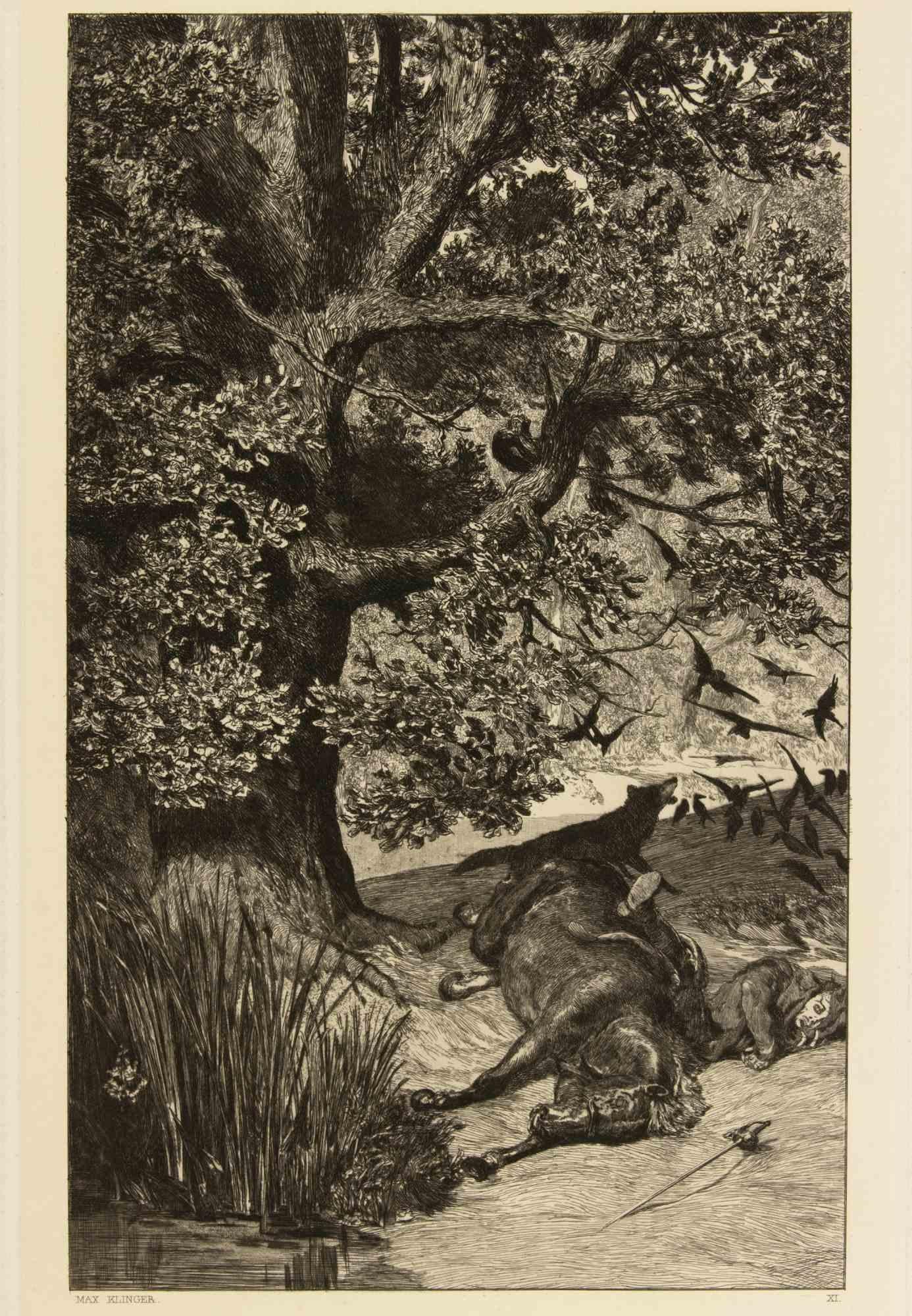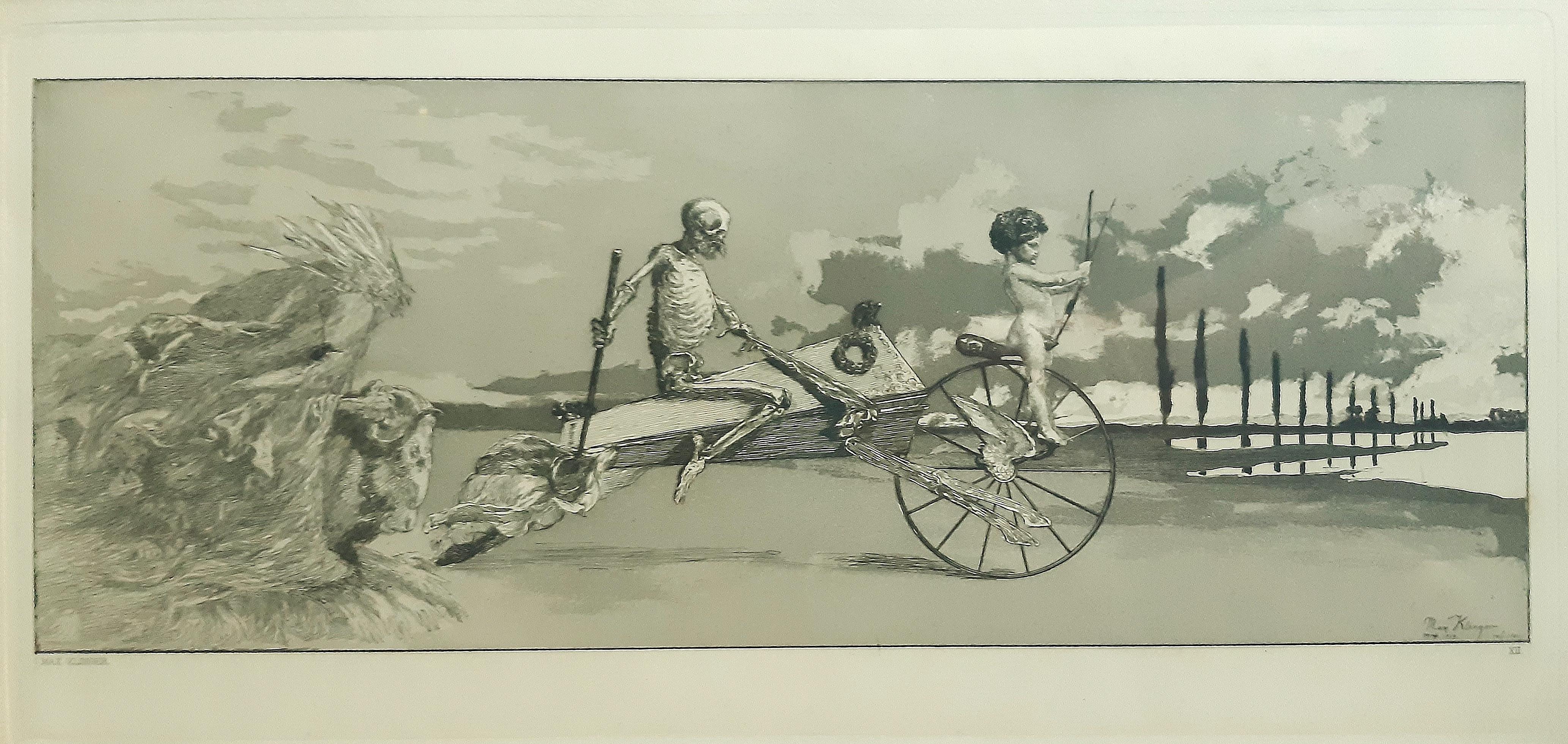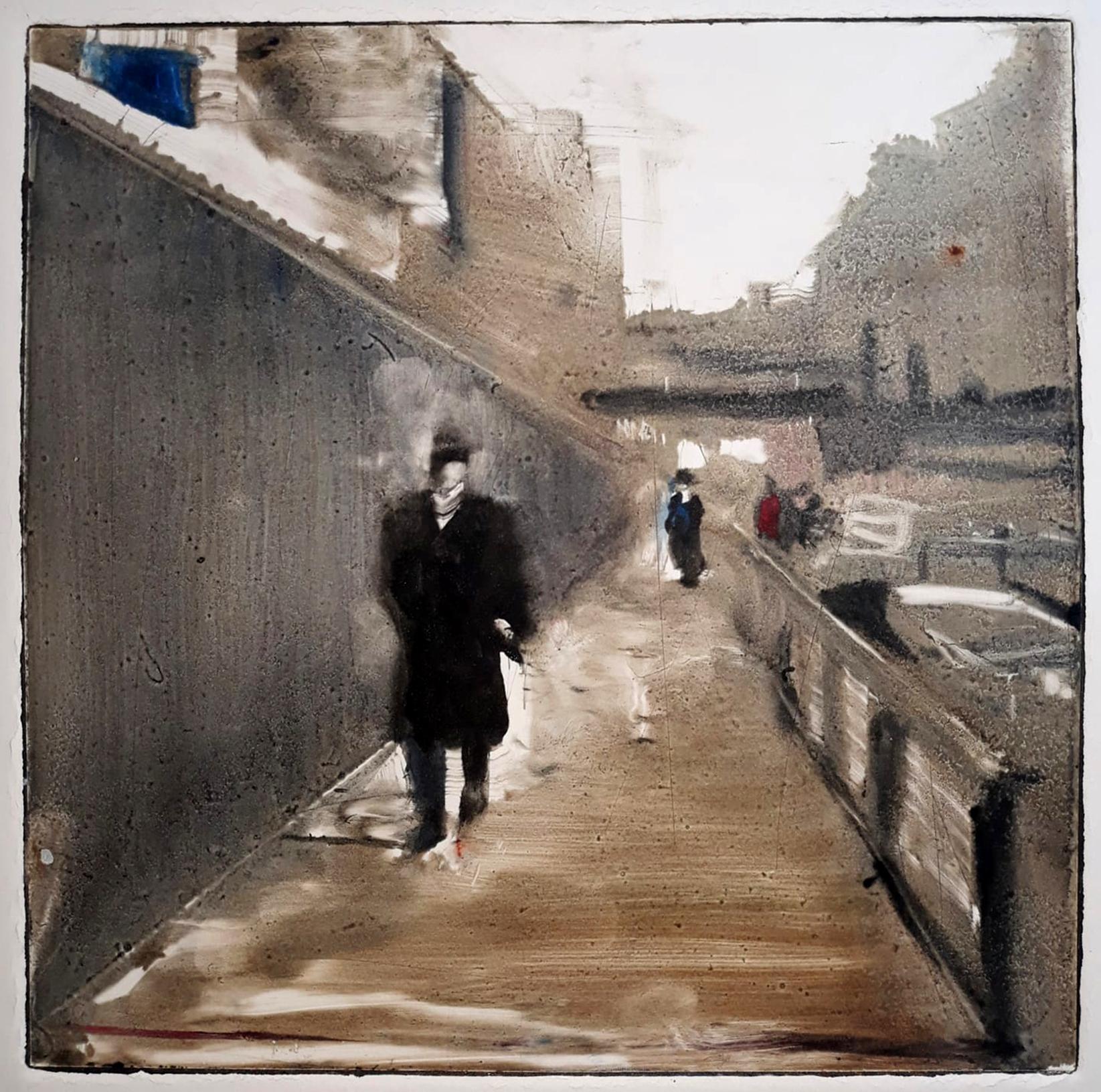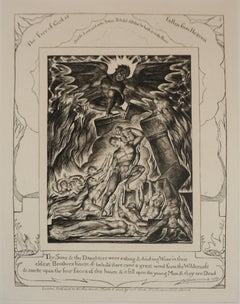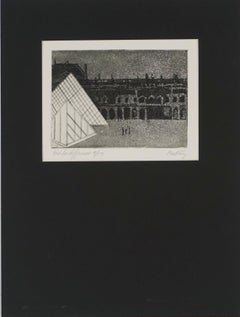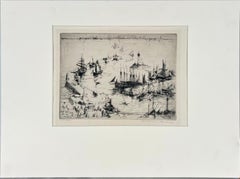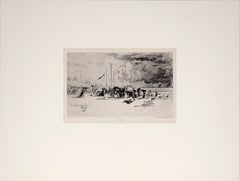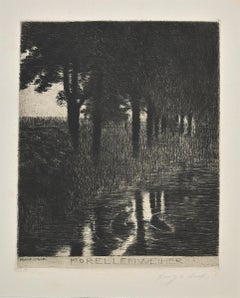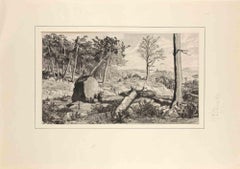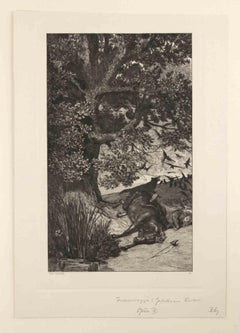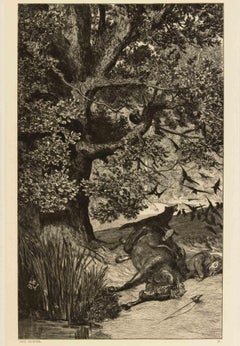Articles similaires à "The Graces Lie Shy" Intaglio Etching
Vous voulez plus d'images ou de vidéos ?
Demander au vendeur plus d'images ou de vidéos
1 sur 13
Chaim Koppelman"The Graces Lie Shy" Intaglio Etching1958
1958
À propos de cet article
"The Graces Lie Shy" intaglio etching by Chaim Koppelman (American b.1920 d.2009).
Moody etching by prominent American printmaker and educator Chaim Koppelman. In this piece a nude female figure is laying in a patch of grass at the bottom right corner, she is ringed in by a row of rocks, behind which a man with a large coat and hat stands. Bare tree branches stretch into a dim and textured cloudy sky on either side of them. Both of the figures subtly interact with the background. The lines shaping the woman's body blend in with the grass and the texture of the clouds is visible through the semi-transparent figure of the man. The title of the piece is taken from a poem by Eli Siegel, a friend and mentor of Koppelman; "Even in our dooms/ the graces lie, shy and unperturbed."
The phrase implies that even in difficult situations, a quiet presence of good or divine favor remains undisturbed. This grace may not be immediately apparent, but it is subtle and unwavering. This suggests a theme of finding hope and resilience amidst suffering.
This phrase is reminiscent of a quote by Aeschylus, which speaks of how wisdom can come through suffering. Difficult experiences can lead to a deeper understanding and appreciation for life's graces
Mat size: 24" H x 24" W
Image size: 16" H x 18.75" W
Paper is cut unevenly and measures 19" H x 22.5" W at its widest points.
Numbered and title in bottom left "Ed. 25 The Graces Lie Shy"
Signed in bottom right corner "Chaim Koppelman '58."
Chaim Koppelman (1920–2009) was a distinguished American artist, printmaker, and educator who played a key role in shaping modern printmaking. Renowned for his mastery of etching and aquatint, his work was marked by a bold fusion of classical precision and imaginative freedom. He was deeply influenced by Aesthetic Realism—the philosophy founded by Eli Siegel, which posits that all beauty is a “oneness of opposites.” Koppelman established the Printmaking Department at the School of Visual Arts in 1959 and taught there for nearly five decades. His art, infused with ethical inquiry and psychological insight, was widely exhibited and is represented in major institutions including MoMA, the Whitney, the National Gallery, and the Victoria and Albert Museum. He was a lifelong advocate for Aesthetic Realism, integrating its principles into both his creative process and teaching.
Koppelman’s early training included study under artists such as Will Barnet and Jose de Creeft, and he was active in New York’s vibrant postwar art scene, working with Atelier 17 and the Robert Blackburn Printmaking Workshop. With his wife Dorothy, he co-founded the Terrain Gallery, which became a hub for artists exploring Siegel’s ideas. His work often grappled with social justice and personal conflict, seen in allegorical prints that addressed war, identity, and moral struggle.
- Créateur:Chaim Koppelman (1920 - 2009, Américain)
- Année de création:1958
- Dimensions:Hauteur : 60,96 cm (24 po)Largeur : 60,96 cm (24 po)Profondeur : 6,35 mm (0,25 po)
- Support:
- Mouvement et style:
- Période:
- État:Paper is cut unevenly. Some small tears around the edges which have been stabilized with archival tape. Light discoloration and bending on paper consistent with age. Mat is new.
- Adresse de la galerie:Soquel, CA
- Numéro de référence:Vendeur : JMA 98681stDibs : LU54216433152
À propos du vendeur
5,0
Vendeur Platine
Vendeurs premium dont la note est supérieure à 4,7 et le délai de réponse de 24 heures maximum
Établi en 1986
Vendeur 1stDibs depuis 2014
2 918 ventes sur 1stDibs
Temps de réponse habituel : <1 heure
- ExpéditionRecherche du devis...Expédition depuis : Soquel, CA
- Politique des retours
Certaines parties de cette page ont été traduites automatiquement. 1stDibs ne garantit pas l'exactitude des traductions. L'anglais est la langue par défaut de ce site web.
Garantie d'authenticité
Bien qu'il soit peu probable que la situation se présente, dans le cas où vous rencontreriez un problème d'authenticité d'un article, contactez-nous dans un délai d'un an pour obtenir un remboursement intégral. DétailsGarantie de remboursement
Si votre article n'est pas conforme à la description, est endommagé pendant le transport ou ne vous est pas livré, contactez-nous sous 7 jours pour obtenir un remboursement intégral. DétailsAnnulation sous 24 heures
Vous disposez d'un délai de 24 heures pour annuler votre achat sans motif.Des vendeurs professionnels agréés
Nos vendeurs de renommée mondiale doivent respecter des normes strictes en matière de service et de qualité, afin de préserver l'intégrité de nos fiches produit.Garantie d'alignement des prix
Si vous constatez qu'un autre vendeur a mis en vente le même article à un prix inférieur sur un autre site, nous nous alignerons sur ce prix.Livraison en toute confiance à l'international
Notre réseau de transporteurs de premier ordre propose des options d'expédition spécialisées dans le monde entier, y compris des livraisons personnalisées.Plus d'articles de ce vendeur
Tout afficherIllustrations du livre de Job - « Le feu de Dieu est tombé du ciel »
Par William Blake
"Illustrations du livre de Job" Gravure "Le feu de Dieu est tombé du ciel... Et le Seigneur dit à Satan Voici que tout ce qu'il a est en ton pouvoir".
Gravure, troisième impression ...
Catégorie
années 1870, Symbolisme, Estampes - Figuratif
Matériaux
Papier fait main, Gravure
Lithographie abstraite du Louve Museum avec Pyramids d'E.M Pei
Par Bu King
Lithographie abstraite de La Louve, avec A&M. Pyramides de verre Pei
Lithographie en édition limitée d'un paysage urbain abstrait, avec des champs de couleur jaune et vert fracturés...
Catégorie
Fin du 20e siècle, Cubisme analytique, Estampes - Paysage
Matériaux
Papier, Encre, Aquatinte, Lithographie
Gravure d'une scène portuaire romantique de 1928
Par Armin Hansen
Gravure d'une scène portuaire romantique de 1928
Grands voiliers dans un "Snug Harbor" par Armin Carl Hansen (américain, 1886-1957). Sur papier vélin.
Image, 6 "H x 8 "W
Feuille, 9....
Catégorie
années 1920, Impressionnisme américain, Estampes - Paysage
Matériaux
Papier vergé, Eau-forte
"Un Grain à Trouville" de L'Illustration Nouvelle
Par Félix Hilaire Buhot
"Un Grain à Trouville" de L'Illustration Nouvelle
Gravure dramatique d'une tempête en approche par Félix Hilaire Buhot (français, 1847-1898). Des personnes sont rassemblées sur une ...
Catégorie
années 1870, École de Barbizon, Estampes - Paysage
Matériaux
Papier vergé, Eau-forte, Aquatinte
Old Houses, Milbank Grosvenor Road Londres 1906
Par Joseph Pennell
Old Houses, Milbank Grosvenor Road Londres 1906
Il s'agit d'une gravure de Grosvenor Road Old Houses, réalisée en 1906 par le graveur américain et biographe de Whistler Joseph Penne...
Catégorie
Début des années 1900, Impressionnisme américain, Estampes - Paysage
Matériaux
Papier fait main, Eau-forte
« Conquering The Wilderness » - Expedition Lewis and Clark gravure originale
Par Robert Hogg Nisbet
« Conquering The Wilderness » - Expedition Lewis and Clark gravure originale
Gravure originale en noir et blanc de 1932 intitulée "Conquering The Wilderness" par Robert Hogg Nisbet...
Catégorie
années 1930, Impressionnisme américain, Estampes - Figuratif
Matériaux
Papier vergé, Eau-forte
Robert Hogg Nisbet« Conquering The Wilderness » - Expedition Lewis and Clark gravure originale, 1932
760 $US Prix de vente
20 % de remise
Suggestions
Forellenweiher - Eau-forte et pointe sèche de Franz Von Stuck - années 1890
Par Franz von Stuck
Forellenweiher est une magnifique gravure et pointe sèche en noir et blanc sur papier crème à larges baguettes réalisée par Franz von Stuck en 1890-1891.
...
Catégorie
années 1890, Symbolisme, Estampes - Figuratif
Matériaux
Papier, Pointe sèche, Eau-forte
Opus IV, Simplicius in der Waldeinode - gravure de Max Klinger - 1881
Par Max Klinger
L'opus IV, Simplicius in der Waldeinode (Simplicius dans la nature sauvage) appartient à une série d'estampes appelées Intermezzi réalisées par Max Clinger, publiées par Nurnberg : S...
Catégorie
années 1880, Symbolisme, Estampes - Figuratif
Matériaux
Eau-forte
Peinture de Max Klinger - Rider tombé - 1881
Par Max Klinger
Fallen Rider est une œuvre d'art moderne réalisée par Max Klinger en 1881.
L'œuvre appartient à une série d'estampes appelée Intermezzi réalisée par Max Calle, publiée par Nurnberg ...
Catégorie
années 1880, Symbolisme, Estampes - Figuratif
Matériaux
Eau-forte
Peinture de Max Klinger - Rider tombé - 1881
Par Max Klinger
Fallen Rider est une œuvre d'art moderne réalisée par Max Klinger en 1881.
L'œuvre appartient à une série d'estampes appelée Intermezzi réalisée par Max Calle, publiée par Nurnberg ...
Catégorie
années 1880, Symbolisme, Estampes - Figuratif
Matériaux
Eau-forte
Amor, Tod und Jenseits - Gravure de M. Klinger - 1881
Par Max Klinger
Amor, Tod und Jenseits, (Cupidon, la mort et l'au-delà) est une gravure et aquatinte originale sur papier Chine collé, réalisée par Max Klinger en 1881, planche XII extrait de "Int...
Catégorie
années 1880, Symbolisme, Estampes - Figuratif
Matériaux
Eau-forte, Aquatinte
1 302 $US Prix de vente
30 % de remise
Ghost of New York 2, paysage urbain monochromatique et dramatique aux accents surréalistes.
Par Tom Bennett
Une des séries de monotypes à l'huile sur papier fin pour gravure. Monochrome avec des couleurs subtiles. Image sombre, symboliste/expressionniste, reflétant l'ambiance actuelle et p...
Catégorie
années 2010, Symbolisme, Estampes - Paysage
Matériaux
Monotype, Papier d'archives
